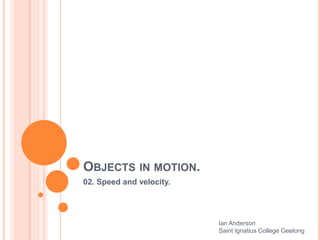
Objects in motion - 02 Speed and velocity
- 1. OBJECTS IN MOTION. 02. Speed and velocity. Ian Anderson Saint Ignatius College Geelong
- 2. DO YOU REMEMBER? Distance is a measure of how far an object travels over a certain period of time. For example if you drove from Geelong to Sydney, your distance travelled would be 940 km. When you return to Geelong, your total distance travelled would be 1860 km.
- 3. DO YOU REMEMBER? Displacement however describes the change in position of an object and its direction over a certain period of time. For example if you drove from Geelong to Sydney, your displacement would be 940 km N. When you return to Geelong, your displacement would be 0.
- 4. WHAT IS SPEED? Speed is a measure of how fast a moving object is travelling. Speed is the rate at which distance is covered. Speed is measured in SI units of metres per second (m/s or ms-1). For cars you will often find it measured in kilometres per hour (km/h or kmh-1). Speed is a scalar quantity because it only has size and no direction.
- 5. WHAT IS SPEED? The speedo on a car measures instantaneous speed. Instantaneous speed is the speed at any moment in time. More often we talk about average speed. Average speed is the total distance covered by an object per given time period.
- 6. CALCULATING SPEED. Average speed = total distance covered per given time period. Average speed = 𝑑𝑖𝑠𝑡𝑎𝑛𝑐𝑒 𝑡𝑖𝑚𝑒 𝑠 𝑎𝑣 = 𝑑 𝑡
- 7. WHAT IS VELOCITY? Velocity is speed in a given direction. Velocity is the rate at which distance is covered in a given direction. Velocity has the same SI units as speed (m/s or ms-1), with the same direction as the displacement. Velocity is a vector quantity because it has both size and direction.
- 8. Average velocity = total distance and direction covered per given time period. Average velocity = 𝑑𝑖𝑠𝑝𝑙𝑎𝑐𝑒𝑚𝑒𝑛𝑡 𝑡𝑖𝑚𝑒 𝑣 𝑎𝑣 = 𝑑 𝑡 CALCULATING VELOCITY.
- 9. POSITION-TIME GRAPHS. Position-time graphs (also called displacement-time graphs) show the total distance travelled by an object over time. Position-time graphs can be used to determine The displacement of an object at any point in time. The speed or velocity of an object at any point in time.
- 10. POSITION-TIME GRAPHS. Position-time graphs (also called displacement-time graphs) show the total distance travelled by an object over time. Position-time graphs can be used to determine The displacement of an object at any point in time. The speed or velocity of an object at any point in time.
- 11. POSITION-TIME GRAPHS. The gradient of a position-time graph gives you speed of the object. A steep position-time graph indicates a faster speed than a graph with a lesser slope. A horizontal position-time graph indicates that the object is at rest. Source: Rickard et al. (2006)
- 12. POSITION-TIME GRAPHS. To calculate the average speed using a position- time graph, you need to calculate the gradient of the slope formed by the line joining the position of your initial position with the final position. Source: Sharwood et al. (2006)
- 13. POSITION-TIME GRAPHS. Use the position-time graph to answer the questions following. Source: Sharwood et al. (2006)
- 14. POSITION-TIME GRAPHS. 1. At what time/s was the object stationary? Answer = Between 0 & 30 s and again between 60 & 80 s. Source: Sharwood et al. (2006)
- 15. POSITION-TIME GRAPHS. 2. What was the objects distance from it’s starting point at t=60 s? Answer = 60 m Note: At 60 s the object’s displacement is -20 m from point (P). Source: Sharwood et al. (2006)
- 16. POSITION-TIME GRAPHS. 3. What was the objects displacement from it’s starting point at t= 60 s? Answer = 60 m S Source: Sharwood et al. (2006)
- 17. POSITION-TIME GRAPHS. 4. What was the objects average speed between 80 and 100 s? Answer = Sav = 1 m/s Source: Sharwood et al. (2006)
- 18. POSITION-TIME GRAPHS. 5. What was the objects average velocity between 80 and 100 s? Answer = Sav = 1 m/s N Source: Sharwood et al. (2006)
- 19. BIBLIOGRAPHY. Rickard, G., Phillips, G., Ellis, J., Jeffery, F., & Roberson, P. (2006). Science Dimensions 4: Coursebook. Melbourne: Pearson Education Australia. Sharwood, J. (Ed.). (2006). Science Edge 4. Melbourne: Thomson Learning.
Notas del editor
- Speed and velocity are the same for objects that have moved in a straight line only.
